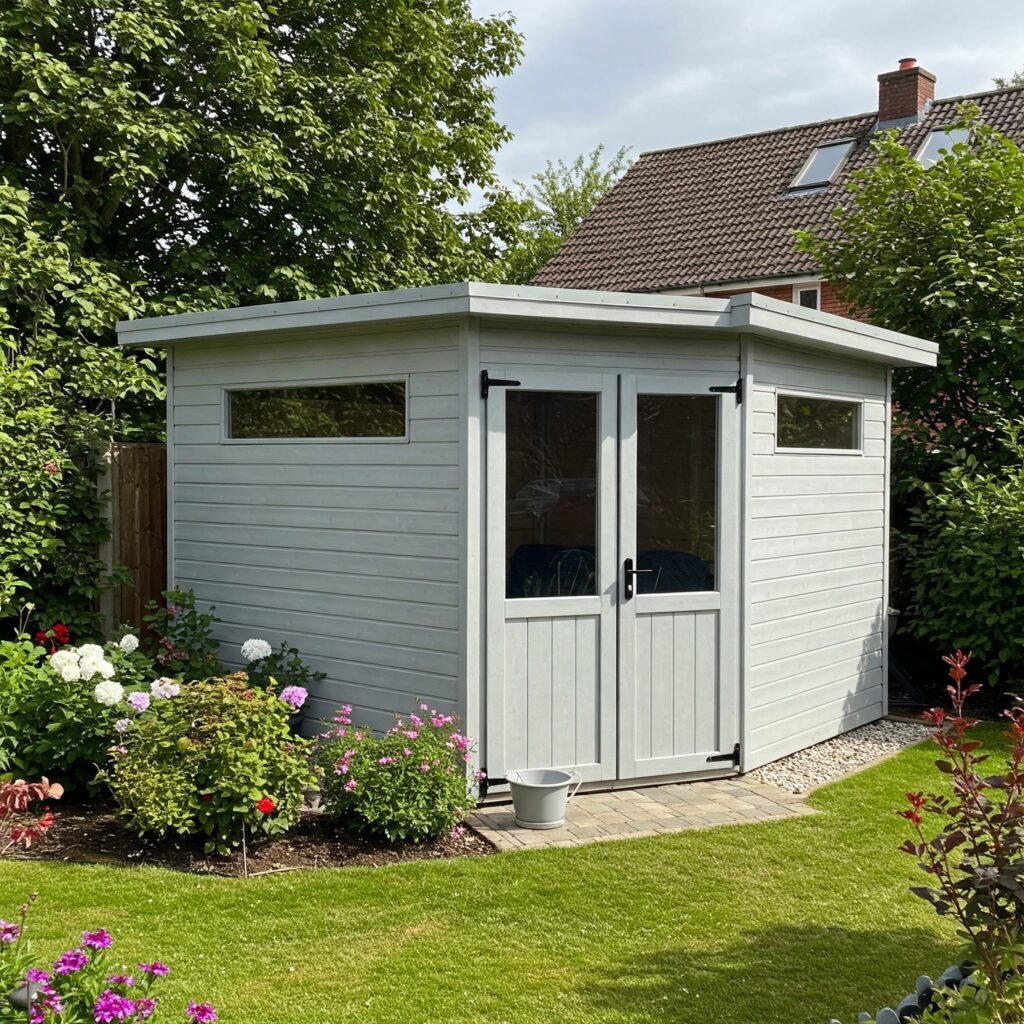If you’ve ever considered upgrading your outdoor space, starting with an insulated garden shed is a smart and practical decision. Whether you want to create a year-round workspace, store tools safely, or even build a cozy retreat, investing in an insulated garden shed offers many advantages. This long tail keyword may not be highly competitive, but the benefits of having one are huge.
In this guide, we’ll walk you through the top 7 reasons why an insulated garden shed could be the best addition to your property. We’ll cover the insulation types, design options, and all the ways you can use a shed throughout the year.
1. Insulated Garden Shed vs. Traditional Shed: Why It Matters
The first and most important point to understand is the difference insulation makes. A regular shed provides storage, but an insulated garden shed goes a step further.
It helps maintain a steady interior temperature, keeping your tools, plants, or workspace safe from extreme weather. While traditional sheds are susceptible to condensation, mold, and rot, an insulated garden shed can protect against all these issues.
This alone is a game-changer, especially if you live in areas with fluctuating weather patterns.
2. Climate Control: Why an Insulated Garden Shed Is Perfect All Year
One of the standout benefits of an insulated garden shed is the ability to control temperature and humidity. In summer, insulation keeps it cooler inside, and in winter, it prevents the cold from seeping in.
This is especially valuable if you’re using the shed as a workspace or garden office. Even if it’s just a storage unit, temperature control ensures that items like paint, electronics, or gardening tools stay in top shape regardless of the season.
By having a stable internal climate, you’ll avoid common problems like rust, frozen pipes, or dried-out wood.
3. Boost Property Value with an Insulated Garden Shed
Believe it or not, an insulated garden shed can increase your property’s resale value. Buyers love seeing additional usable space—especially if it’s already upgraded with insulation, electricity, and stylish finishes.
It’s not just a shed—it’s an extension of your home. Whether it becomes a home office, yoga studio, or guest space, a high-quality, well-insulated structure adds to the overall appeal of your home.
And if you’re renting out your space, it can be a unique selling point that commands higher rental income.
4. Multiple Uses of an Insulated Garden Shed
An insulated garden shed is more than just a place to store lawnmowers and flower pots. Its usability extends throughout the year and across a wide variety of needs.
Here are some creative ways people are using their insulated sheds:
- Home Office – Escape distractions inside the house.
- Workout Room – Stay fit without heading to the gym.
- Hobby Studio – Paint, craft, or write in peace.
- Greenhouse – Control temperature and humidity for your plants.
- Playroom – Give the kids a safe space to play.
- She-Shed or Man Cave – Enjoy your alone time in a cozy retreat.
Each of these options works better when your shed is insulated, maintaining comfort and utility.
5. Insulated Garden Shed Materials and Design Options
When planning your insulated garden shed, choosing the right materials is essential. The walls, roof, and flooring must all work together to retain heat and regulate moisture.
Common insulation materials include:
- Foam Board – Affordable and effective for walls and roofs.
- Fiberglass Batts – Easy to install and widely available.
- Spray Foam – Excellent for filling gaps and preventing airflow.
- Reflective Foil – Great for reducing heat during summer months.
Besides insulation, consider:
- Double-glazed windows for temperature and sound control.
- Weather-sealed doors to prevent drafts.
- Ensure roof ventilation to prevent excess condensation.
Design-wise, you can just opt for something that complements your garden. Whether you prefer rustic wood finishes, sleek modern panels, or cozy cottage looks, an insulated garden shed can be both functional and beautiful.
6. Energy Efficiency: Save Money with Insulation
Many people don’t realize this, but an insulated garden shed can help you save energy. If you use heaters or AC units inside your shed, insulation ensures that the warm or cool air doesn’t escape.
This means lower energy bills, more eco-friendly use of resources, and a smaller carbon footprint. And if your shed is hooked up to solar panels, the benefits are even greater.
While the upfront cost might be slightly higher compared to an uninsulated version, you’ll start noticing savings over time—especially in climates with extreme temperature variations.
7. Easy to Maintain and Long-Lasting
An insulated garden shed is also a wise investment because of its durability. By reducing moisture buildup, you protect the structure from rot, mold, and pests—common issues with traditional sheds.
Insulation acts as a barrier, keeping the structure stable and well-preserved over time. This reduces the need for frequent repairs or replacements and keeps your belongings safe from weather damage.
With proper upkeep, your insulated garden shed can last 15 to 30 years or more.

How to Choose the Best Insulated Garden Shed for Your Needs
When selecting an insulated garden shed, there are a few key factors to consider:
- Size – Determine how much space you need, keeping future uses in mind.
- Location – Choose a well-drained, accessible spot in your garden.
- Foundation – A solid base (like concrete or treated timber) is essential for longevity.
- Features – Think about windows, skylights, electrical wiring, and insulation levels.
- Budget – Factor in the cost of insulation, installation, and any extra add-ons.
Remember, it’s always better to invest a little more upfront for quality. A poorly built shed will cost you more in the long run.
Maintenance Tips for Your Insulated Garden Shed
Once installed, here are a few tips to keep your insulated garden shed in top condition:
- Inspect seals and joints regularly for air leaks.
- Clean gutters and downspouts to prevent water buildup.
- Check for pests and apply treatments if needed.
- Ventilate during extreme weather to avoid condensation.
- Repaint or stain the exterior every few years to protect the wood.
Good maintenance ensures your shed stays insulated, attractive, and durable for years.
Cost of Building an Insulated Garden Shed
The cost of an insulated garden shed can vary based on size, materials, and features. Here’s a rough breakdown:
Feature | Estimated Cost (USD) |
Basic Shed Kit | $1,200 – $3,000 |
Insulation Materials | $500 – $1,500 |
Electrical Setup | $300 – $800 |
Interior Finishing | $400 – $1,200 |
Professional Installation | $1,000 – $2,500 |
Overall, you can expect to spend between $3,500 and $8,000 on a quality insulated shed—less if you DIY, more if you go for premium finishes and professional help.
Should You Build It Yourself or Hire a Pro?
Deciding whether to build your insulated garden shed yourself or hire a contractor depends on your skills and time.
DIY Pros:
- Save money
- Customize easily
- Learn valuable skills
DIY Cons:
- Time-consuming
- May lack precision
- Can be difficult if you’re new to construction
If you’re not comfortable with framing, insulation, or electrical work, hiring a professional ensures safety and quality.
Final Thoughts: Why an Insulated Garden Shed Is Worth It
In conclusion, an insulated garden shed is a multi-functional space that adds comfort, value, and usability to your home. Whether you’re aiming to create a peaceful studio, a well-organized workspace, or a protective storage area, insulation is the key to year-round use.
While it may seem like a luxury at first, the long-term benefits—from energy savings to increased property value—make it a practical investment. Plus, with so many design options available, your insulated shed can easily become the most loved part of your backyard.
FAQs About Insulated Garden Sheds
Q: Can I add insulation to an existing shed?
Yes, many people retrofit their sheds with foam boards or fiberglass batts to improve temperature control.
Q: What’s the best insulation material for garden sheds?
Spray foam and foam boards are popular for their efficiency and ease of installation.
Q: Is it okay to use a heater or AC in an insulated shed?
Absolutely! Insulation helps those units work more effectively by preventing air leaks.
Q: Does an insulated garden shed require planning permission?
In many areas, small garden sheds do not require permits—but it’s best to check your local regulations.
Q: How long does it take to build one?
A DIY build may take a few weekends. Professionals can finish in 2–4 days, depending on the complexity.

Pingback: 10 Garden Shed Paint Ideas to Transform Your Outdoor Space